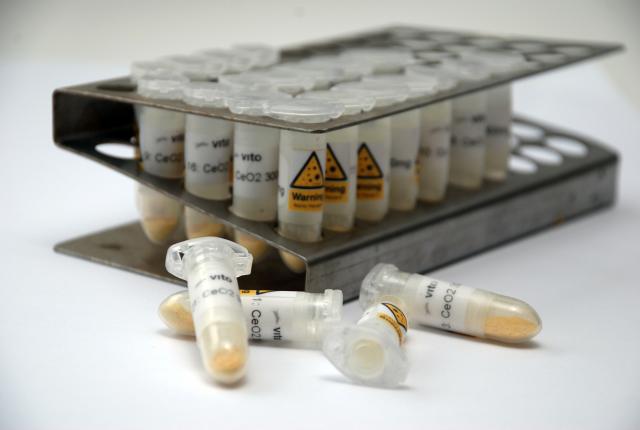Services
In gas-diffusion electrocrystallization, metal ions are removed from aqueous solutions through electrochemical processing, while (composite) (nano) particles are synthesized; thus serving as a strategy to produce added-value inorganic solid and colloidal materials. The physico-chemical characteristics of the materials produced can be tuned by changing a set of process parameters, achieving thus composites with desired functionalities.
For example, cerium oxide nanoparticles can be produced which can be tailored towards electronic packaging, oxidative stress alleviation, or cancer therapy. Another example is the effective immobilization of arsenic, one of the most important inorganic pollutants, into its most stable form pure scorodite particles, at temperatures as low as 50 °C. Furthermore, our technology can produce iron oxides with different degrees of magnetic susceptibility. A wide range of other crystalline materials and nanomaterials are possible, with control of e.g. composition and crystallite size.
A process scale-up is possible for specific applications.
Infrastructure
Reactors
A large set of lab-scale electrochemical reactors equipped to perform gas-diffusion electrocrystallization is available. In these reactors we can already produce 2-3 grams of particles/nanoparticles per day.
Electrochemical instrumentation
All our reactors are coupled to multi-potentiostats (Bio-Logic) and frequency response analyzers to have a fine control of the reaction, monitoring and characterization of the process. We also have a fast-laser diode array that can perform on-line UV/VIS spectrophotometric measurements.
Shape, size, Agglomeration state
Field Emission Gun Scanning Electron Microscopy with STEM detector (FEI, Nova NanoSEM 450 for S(T)EM/EDX analysis))
Particle Size Distribution
Dynamic Light Scattering (DLS) (Malvern Nano ZetaSizer ZSP) with micro-titrator
Specific Surface Area
N2 absorption - BET analysis
Zetapotential
Dynamic Light Scattering (DLS) (Malvern Nano ZetaSizer ZSP) with micro-titrator
Phase Identification, crystallite size
X-ray Diffraction (XRD)
Infrastructure
In risk assessment exposure concentrations are compared with safe concentrations. We follow a step-by-step approach for the input of computerized models for risk assessment, such as Chesar:
- Apply default risk assessment based on realistic exposure scenarios
- Include on site exposure measurements
- Recommend risk mitigation measures
Nanomaterial Risk Assessment
- The assessment of potential risks from nanomaterials is performed with control banding tools, and, if needed, refined with exposure measurements
Control banding models
- Stoffenmanager nano
- Precautionary Matrix
- Consexpo nano
